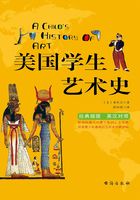
第10章 陶土雕塑
“赤陶”是一种经过烧制的泥土。花盆、砖块,都属于陶土制品;也就是说,它们都是一种经过烧制、变成了褐红色的泥土或者黏土。你们可能都用泥巴做过东西,比如杯子呀,盘子呀;而古希腊人也曾用同样的方法,用同样的材料,即泥巴或黏土,制作过人物雕像呢。他们曾经用黏土制作出比玩具娃娃更小的微型女性雕像,然后再放入火中烧制,从而使得这些雕像不会破碎。烧制的过程,便将这些雕像变成了赤陶。
当时有一种风俗,那就是将这些称为“陶俑”或者“小雕像”的小型人物雕塑品放进坟墓里;人们已经发掘出成千上万件这样的小雕像,并将它们保存进了博物馆。由于它们最初是从希腊一个叫作塔纳格拉的小镇发掘出来的,因此所有这些小塑像都被称为“塔纳格拉陶俑”。它们通常都是手摇扇子或者打着遮阳伞的女性陶俑,并且全部都衣着精美呢。是的,古希腊的贵妇们都有扇子和遮阳伞,与你们如今偶尔还能在电影或者戏剧里看到那种扇子和遮阳伞很相似。但古希腊雕塑与众不同的一点是,这些女性人物身上的穿戴,全都齐整得很呢。
绝大多数小陶俑都是原创作品,但其中也有一些是大型雕塑的仿制品。由于许多的大型雕塑作品都不复存在了,因此这些小型的陶俑仿制品便向我们展示出了原作的模样。不过,它们呈现出来的东西可不仅于此。如果你们想要弄明白古希腊人
than real people.But these terra-cotta statuettes are copied from everyday Greeks.They show ordinary people in everyday activities.
Many of the figurines were painted in bright colors. Some had tiny necklaces of real gold or held bronze ornaments in their hands.But on many of them, the only color left is the brownish red of the clay from which they were formed.To make each figurine the same but a little bit different, they were made of parts like a doll.The heads, arms, and legs were made in separate molds.Then the sculptor would put these parts onto the bodies in different combinations in order to make each figurine the way he thought best.
Figurines were made for the dead;lamps were made for the living. Lamps, which every house had to have, were decorated with figures in low relief.Lamps today, of course, are electric and quite different from those in ancient Greece.These old lamps were very small, seldom larger than your hand, and were made either of terra cotta or bronze.They had a hole in which a twisted piece of string-like cloth was stuffed to make a wick.They held olive
究竟是个什么样子,那就到博物馆里去看一看这些小陶俑吧。那些大型的、著名的大理石雕像,雕刻的都是众神、运动员和勇士。它们差不多全都过于完美,不是真实的古希腊人。而这些小陶俑所描摹的,却都是古希腊人在日常生活中的样子。它们所刻画的,都是普通百姓日常生活的场景。

塔纳格拉陶俑
许多小陶俑上,都漆有亮丽的颜色。有些小陶俑的脖子上,还挂着真金制成的微型项链,或者是手中拿着青铜首饰呢。不过,其中的许多陶俑,如今都只剩下制作这些陶俑所用的黏土本来的那种褐红色了。为了让每尊陶俑都一模一样,只有细微的差别,它们都是像如今制作玩具娃娃的工序一样,用不同的部位组装起来的。头部、胳膊和腿都是用不同的模具进行制作。然后,雕塑家会按照不同的组合方式,将这些部位安装到陶俑身体上去,以便让每尊小陶俑都变成雕塑家心中所想的最佳样子。
这些小陶俑是为死者制作的,而灯具却是为活着的人而制作出来的。每家每户所必需的油灯,上面都雕有浅浮雕的装饰图案。如今我们所用的灯具当然是电灯,与古希腊人所用的油灯已经完全不同了。那些古老的油灯尺寸都很小,几乎大不过你们的手掌,并且要么是用陶土制成,要么便是用青铜制成的。油灯上面有一个孔,人们把一条用布拧成的细绳穿过这个孔,塞入油灯里当灯芯。灯中盛着的是橄
oil or grease that soaked the wick and made it burn when lighted.These lamps gave no more light than a burning match and that was all the light people had at night.Perhaps they did not need more light because they went to bed earlier than we do.The lamps often had Greek gods, goddesses, or other mythological characters on the tops or sides.
Lamps were made in molds, and hundreds or even thousands of lamps were made from one mold. Some of the old molds have been dug up out of the ground and are used to make modern reproductions that are sold today as souvenirs to travelers.Old lamps made of bronze have a patina-a greenish finish showing a softening of the surface that comes with age.New reproductions of lamps made of bronze are sometimes dipped in acid to make them look old, but they have sharper edges than the old lamps and the finish made by the acid bath does not look the same as that eaten away by time.If the reproductions are made of clay, the lamps look cleaner cut and fresher than the old ones.So if you are thinking of buying an ancient lamp, be sure to notice the patina or the freshness of the clay.
Now far away from Greece is another ancient land-China. There was a time when the subjects of the Chinese emperor had their lives saved by terra cotta.Can you imagine how?
Well, in 250 B. C.the first Chinese Emperor Qin Shih Huang Ti made everyone very happy when he decided not to do what his father had done, which was to bury his servants and soldiers alive with him when he died.Instead he had sculptors make life-size terra-cotta replicas of each and every servant and soldier.You see, the emperor had not had an
榄油或者动物油脂,灯芯浸透油脂之后,点着就会燃烧。这些油灯,比一根划着的火柴亮不了多少,可那时的人,晚上全靠这个照明呢。没准他们并不需要太亮,因为当时的人都比我们睡得早。油灯的顶上或者侧面,通常都雕有古希腊众神或其他的神话人物形象。
油灯是用模具制成的,而一个模具可以制造出数百盏甚至数千盏油灯来。我们已经出土了一些古老的模具,并且用它们制造出了现代的仿制品,然后再将这些仿制油灯当成纪念品卖给游客。历史悠久的青铜油灯上,会形成一层铜绿,即一种绿色的表层,表明随着时间的推移,油灯的表面已经软化了。人们有时会把新仿制出来的青铜油灯放入酸液中浸泡,使它们看上去显得古旧;但它们的边缘会比真正的古灯清晰,而经过浸酸做旧形成的表层,看上去也会与长时间腐蚀形成的表层不一样。假如仿制品是用陶土做成的,那么油灯的外形轮廓就会比真正的古灯更清晰,颜色也会更鲜艳。因此,假如打算购买一盏古灯的话,那你们一定得注意油灯表面的铜绿,或者陶土颜色的鲜艳程度才行。
注意,在离古希腊很远的地方,还有另一个古国,那就是中国。曾经有过那么一个时期,陶土还救了中国皇帝及其手下臣民的性命呢。你们想象得出那是怎么一回事吗?
好吧,在公元前250年,中国的第一任皇帝秦始皇决心不走自己父亲的老路,决定自己死后,不再将手下的仆从和士兵活埋来殉葬,这让国人十分高兴。他命雕塑匠人给自己手下的每一个仆从和士兵都制作了真人大小的陶俑。你们都知道,
easy time during his life and he knew he needed protection in the afterlife.
Brightly painted uniformed bowmen, infantrymen, and charioteers had distinct hands and faces, each with different features and expressions. Their hands and heads were detachable, carefully fashioned to match each man in the army just as they were in real life.
Can you imagine how they were found after all this time?Well, one day more than two thousand years later, a farmer was digging for a well. Instead of finding water, he found six thousand terra-cotta warriors-all buried underground in a vast field.Was he surprised!So when you go digging in your backyard next time, remember the farmer in the fields in China just in case you, too, find the surprise of your life.
这位皇帝生前并没有过上什么安逸的日子,因此他明白自己在来生需要这些人的保护。
这些陶俑都涂上了亮丽的颜色,并且着装统一,里面有弓箭手、步兵和驾驶战车的人;它们都有着独特的双手和脸庞,并且每个人都有着不同的容貌和表情。它们的双手和头部是可以拆卸的,并且都经过精心制作,以符合军中每一个人的实际情况。
你们想不想得出,经历这么久的时间之后,人们是怎样发现它们的呢?好吧,两千多年后的一天,一名农夫正在打井。他并没有打出水来,却发现了六千尊兵马俑;它们全都深埋于地下一片广袤的区域内。他惊讶得目瞪口呆!因此,下次你们再在自家后院挖掘的时候,可要记得那个在地里打井的中国农夫哦;说不定,你们也会因此而发现生活中的惊喜呢。